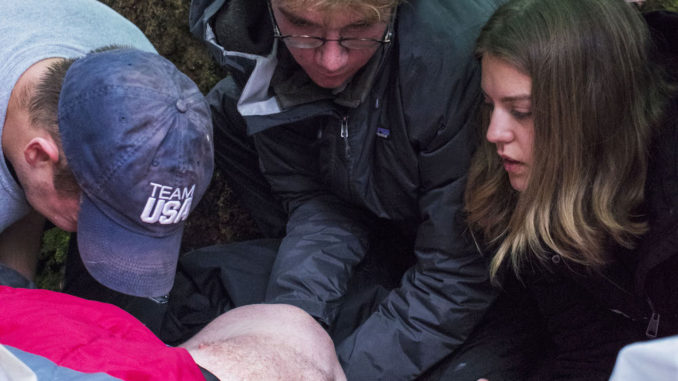
By Sherlock Ortiz
You are first responders, not last providers,” Pablo Velasco, one of the instructors during our Wilderness First Responder (WFR) training, said. Velasco was referring to our role in a medical emergency. As responders we would be the first on scene, but not necessarily the last person to take care of a patient if and when we handed them off to someone with further medical training.
The WFR training is run by the National Outdoors Leadership School (NOLS) on campus over winter break. The training was an 80-hour medical course spread over 10 days covering how to treat everything from simple blisters to dangerous impaled objects to a potentially-deadly High-Altitude Pulmonary Embolus. Twenty-nine people, among them 11 Lewis & Clark students (including myself) and one LC Area Director, challenged themselves to learn how to deal with emergencies, large and small, in a wilderness context.
The key to wilderness medicine, as we were repeatedly reminded, is to keep in mind that advanced medical help could be hours, if not days away. There are no ambulances to call, helicopters cannot fly everywhere at all hours and your training could possibly save a life.
We are trained to arrive on a scene and “assess, assess, assess.” The course was split up between lectures, classroom activities and outdoors scenarios. Lectures covered a lot of the theoretical materials and the specific knowledge for various kinds of situations that might arise.
“The tips about hypothermia, lung problems, and different splinting techniques (were the most helpful),” Jack Norman ’21 said via email.
Classroom activities included a lot of splinting practice, including makeshift splints for arms, legs or a pelvis, as well as ankle and knee braces. The use of CPR and an automatic external defibrillator (AED) was also taught.
Each day featured at least three to four scenarios in or near the ravine by Templeton so as to try and recreate the outdoors feeling of a backcountry incident. Most scenarios involved one patient and one or more responders interacting. The patients were varied, from a backpacker with food sickness to little Johnny at summer camp who was hiding the fact that a stallion kicked him in the back. The patients’ situations were varied too: some were at the side of a trail and others at the bottom of a cliff after a hypothetical rock climbing accident.
“There was one in particular where it was an MCI (Mass Casualty Incident) scenario,” Nikki Corey ’21 said via email. “We had three patients and they were each being treated by different people. The patient I was treating was physically shaking, cold to the touch and convincingly confused and distressed. As we walked on scene as responders to this scenario the collective stress level was definitely heightened.”
“I (now) have the skills to help if someone gets hurt in the wilderness or at least help get them evacuated if they are beyond my ability to treat,” attendee Maia Richards-Dinger ’21 said via email.
Being a certified WFR means being able to take the critical first steps in a medical emergency. It means recognising that you will be first on scene, able to size up the situation, assess a patient, help where able to and, if necessary, get further help. We are not last providers, but first responders. The final goal is to be able to evacuate a patient so that they are able to return to the wilderness and keep hiking another day.
Subscribe to the Mossy Log Newsletter
Stay up to date with the goings-on at Lewis & Clark! Get the top stories or your favorite section delivered to your inbox whenever we release a new issue.

Leave a Reply